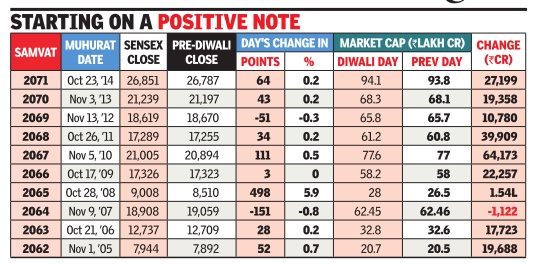Sensex
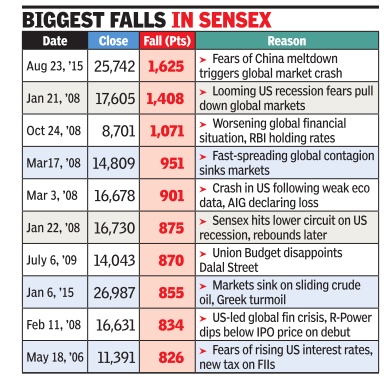
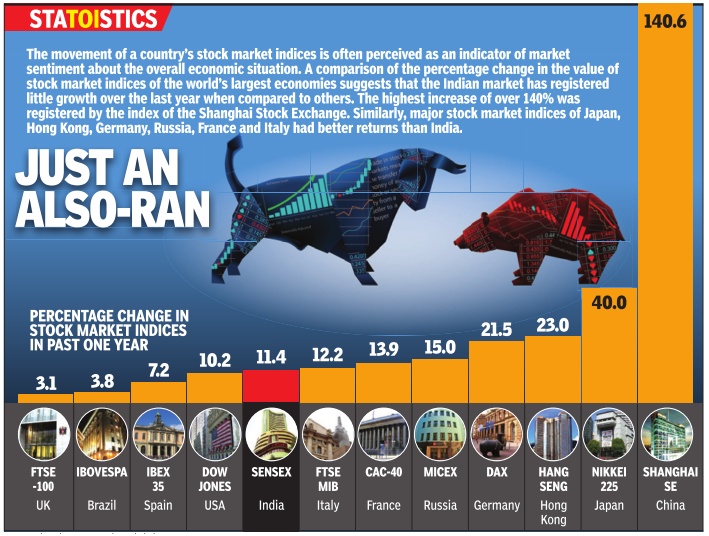
This is a collection of articles archived for the excellence of their content. |
Sensex and Muhurat trading
Sensex rises marginally in Muhurat trading
Mumbai: TIMES NEWS NETWORK The Times of India Oct 25 2014
At any gathering of brokers, analysts and investors, a major part of the conversation currently revolves around the new government and its policies. Thursday evening's Muhurat trading session at P J Towers, the headquarters of BSE in south Mumbai, which saw the sensex closing 64 points higher at 26,851, was no different. Top brokers and independent money managers shared their views on almost every decision of the Narendra Modi government and its impact on the market, and there were enough number of willing listeners as the one-and-halfhour long special trading session continued at the exchange's Convention Hall.
During the session, which was to mark the start of Samvat Year 2071 -the New Year for the trading community on Dalal Street dominated by the Gujaratis -the sensex's gains were backed mainly by index heavyweights like Reliance Industries, TCS and ITC. Nifty closed 19 points higher at 8,015.
Usually, the indices close higher after the Muhurat session as traders do not sell shares during this session that is preceded by a puja of God dess Lakshmi, who symbolizes wealth and prosperity .
The day's session at BSE started with felicitation of some of the top brokers on the exchange during the past one year, and then the opening bell ringing ceremony . This year, Bollywood actor Kajal Aggarwal, of “Singham“ fame, rang the opening bell. In Samvat 2070, the sensex had gained 26%.
There was a bullish undertone in what the brokers, money managers and analysts had to say as they have huge expectations from the Modi government. However, there were some notes of caution as well.
Contents |
Sensex versus the NSE
NSE top bourse, but sensex bigger brand
Partha Sinha The Times of India Mar 05 2015
A little more than two decades ago, the National Stock Exchange (NSE) -currently the largest bourse in India in terms of turnover -was created by the government to compete with and break the monopoly of the Bombay Stock Exchange. BSE then was a cosy brokers' club with a complete dominance over the stock trading in the country . To counter trading by a limited number of brokers, the gov ernment created an exchange that was the country's first computer-driven online stock exchange, promoted by some of the leading institutions of that time.
In its initial days, NSE enjoyed the monopoly of setting up trading terminals across the country , while its main rival BSE was not allowed to do so. It was only after NSE captured a large chunk of share trading across the country and also dominated regional stock exchanges that BSE got the permission to go pan-In dia. That, too, after a huge struggle by BSE brokers.
What helped NSE to outwit BSE and grow rapidly was the savvy use of technology . The launch and spread of online trading, which also created several jobs among the youth, was a big differentiator. According to one institutional dealer, in mid-1990s, he got his first job with a family-run broking firm simply because he had very basic knowledge of computers. “My employer would treat me with a lot of respect and would often brag to fellow brokers that he had someone who knew computers,“ the dealer said.
Along with computerized trading, NSE also led the automation and paperless trading in the Indian market. NSDL, the first depository in the country is a subsidiary of NSE that led the demat revolution in India. Also, it was the first exchange to have a clearing corporation, an independent third party that facilitated settlement and helped low er trading and settlement risks in the market.
Despite the dramatic rise and rise of NSE, at least on one count it still falls behind BSE: The Brand. Sensex as a brand that punches way above its weight compared with NSE's nifty. “Although most of the brokers look at nifty to gauge investor sentiment, outside of this community , among the general mass, sensex still remains the primary gauge for the robustness of the market and the economy ,“ said a former exchange official.
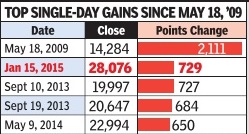
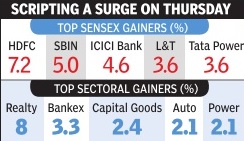
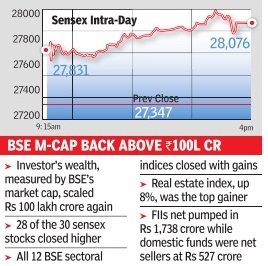
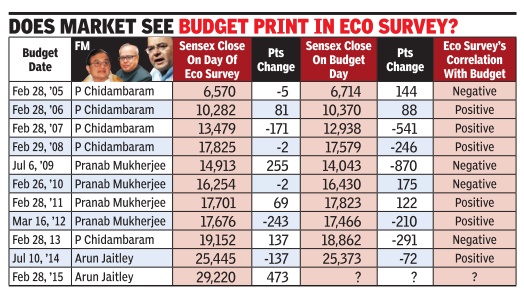
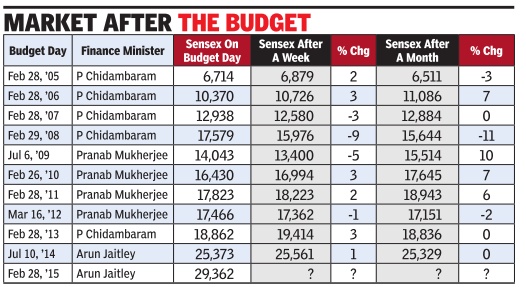
Co-relation between monsoon and market
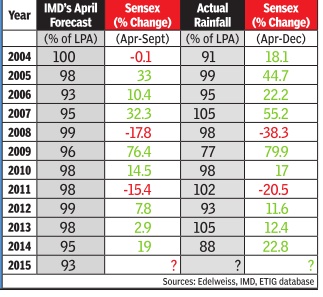
Apr 24 2015
Although Dalal Street is feeling the jitters of a below-normal monsoon prediction by the Indian Meteorological Department, data show no correlation between Met's predictions, actual rains and the overall market trend. For example, 2009 saw the worst drought in recent times with the country witnessing 77% of the long period average (LPA) rainfall during monsoon.However, that year the sensex rallied 76% between April, when Met's initial monsoon estimates are published, and September, when the monsoon officially ends. On the other hand, the sensex fell over 20% in 2011, the year that saw one of the best monsoons in over a decade
Manic Mondays
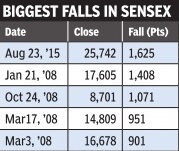
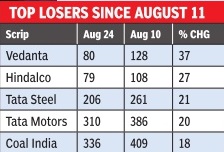
The Times of India, Aug 25 2015
7 of 10 biggest mkt slumps on Mondays
They don't call it Manic Monday for nothing. Seven of the 10 biggest single-day falls on Dalal Street have taken place on a Monday. This is true for both intra-day crashes as well as sensex closing levels.The second highest closing fall of 1,408 points was also on Monday, January 21, 2008.
Muhurat day trading
2014-15/ Samvat 2071: Worst in four years
The Times of India, November 11, 2015
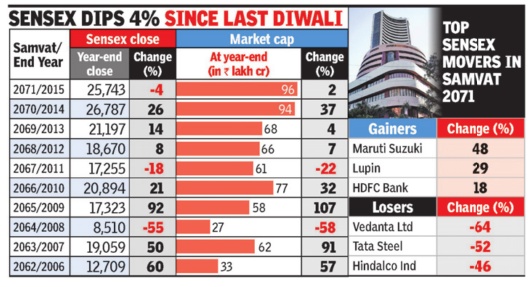
Samvat 2071 in the traditional calender of the trading community on Dalal Street, has turned out to be the worst year for the sensex in terms of returns in the last four years. The benchmark index lost 4% even as investors waited for the 18-monthsold Narendra Modi government to deliver on its promises of faster economic growth and development. In terms of investors' wealth, however, the year saw about Rs 2 lakh crore being added to BSE's market capitalization at Rs 96.1lakh crore, reflecting smarter gains for nonsensex stocks. Newly listed stocks like Interglobe Aviation (IndiGo airlines) and Coffee Day Enterprise (Cafe Coffee Day), which together have contributed about Rs 35,000 crore worth of market value, also contributed to investors' wealth during Samvat 2071, exchange data showed.
The year, which started strong, ended on a cautious note for investors on the back of the Bihar drubbing suffered by the Modi-led NDA. However, the go od sign for Dalal Street is that two days after the elections results were out, the government liberalized foreign investment rules in 15 sectors, including manufacturing, defence, banking and agriculture through executive orders. This was “reflective of the government's commitment to boost investment as well as improve the ease of doing business“, said a note from Radhika Jain, partner, Walker Chandiok & Co LLP , an management consultancy and advisory firm.
Market players said it was a good sign that the poll drubbing is not forcing the government to take the populist route and dump the economic reforms process for growth and development. Some analysts said the poll debacle may turn out to be a blessing in disguise for the government and the economy . Others feel the Modi government would be less effective to take the legislative route to reforms given its minority position in the Rajya Sabha and therefore will depend more on executive decisions to get the reforms process moving forward. In such a situation, investors willing to stay invested for the long run will benefit.
“It will be a tough year for the market, especially considering the pipeline of primary issues and government divestments,“ said Arun Kejriwal, director, KRIS. “Making money will entail discipline and skill sets. Reforms will galore over the next 2-3 quarters. However, it will take longer for tangible results to be seen,“ Kejriwal said.
2015/ Samvat 2072: Best gains in 7 years
The Times of India, Nov 12 2015
Sensex's best Muhurat gains in 7 yrs
Rises 124 points on 1st day of samvat 2072 trading on govt's FDI move
The Muhurat day trading for Vikram Samvat year 2072, the new year for the Hindu lunar calendar, ended on a strong note, thanks mainly to the government's late Tuesday announcement allowing easier foreign investment in 15 sectors, with the sensex ending 124 points higher, its best Diwali day closing in seven years. Although the mood among those present at BSE's Convention Hall was downbeat compared to last year when the Modi-led government was just a few months old, veterans at Dalal Street said the Centre was working hard and its decisions relating to the economic reforms process is expected to start showing results soon.
On Diwali day , brokers worship Lakshmi, the Godess of wealth and prosperity at BSE's Convention Hall which used to be the trading rink till computers replaced the open outcry system of trading. Brokers, along with their family members, trade on terminals set up temporarily for the Muhurat session at the same hall. According to another official at a broking house, the government's attempts to bo ost investment in the economy is bearing results, albeit slowly , and some private sector companies are also starting to invest in building capacities. The gains on Diwali day's one-and-half hours special trading session was led by Axis Bank, Sun Pharma and L&T, while Hero MotoCorp and ITC were the top laggards. The session also added nearly Rs 63,500 crore to investors' wealth with the BSE's market capitalisation now at Rs 96.78 lakh crore. Institutional participation was minimal as it was a banking holiday . Extending its gains for the third straight day, gold prices advanced by Rs 15 to Rs 26,250 per ten grams in muhurat trading at the bullion market on increased buying by jewellers, driven by the ongoing festive season. Token buying activity on the auspicious occasion of Diwalialso supported the upside, traders said. Silver also edged up by Rs 25 to Rs 34,900 per kg. AGENCIES
See also
Sensex <> The stock market: India <> Mutual Funds: India <> Rupee: India
